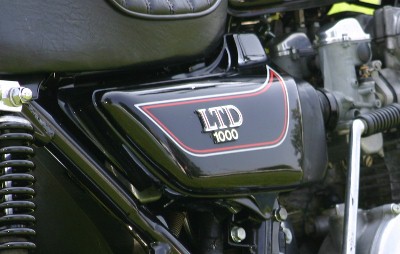
Kawasaki Model Codes
This is a basic explanation of how Kawasaki's model codeing system works. It is a little harder for folow that that of Yamaha or Suzuki's system. With a little understanding of the basic system it simplifies it a little and keeps you from buying incorrect replacement parts and accessories for your Kawasaki. Most of the information is based on 250cc and larger street models imported to the USA.
Breaking Down The Model
The basic way to break down a bikes model is seperate it's basic parts. Lets take the model below as an example.
'78 KZ1000B2
KZ
1000
B
2
Full Name
Engine Family
cc
Type
Year
As you can see above the first section is the entire name
'78 KZ1000B2 and this tells you all you need to know to
basically identify this bike
and what parts it uses.
___________________________________________________________________________________
The second section shows you the first break-down is the engine family this bike belongs
to. In this
case it is the KZ family which basically is two valves per cylinder, four
stroke engines with in-line cylinders from single cylinders to as many as
six cylinders.
___________________________________________________________________________________
The third section shows the second break-down which is it's listed cc (cubic
centimeters) range which is 1000.
Typically based on a round-up or round-down of the actual cc of the engine.
In this bikes case the actual size is 1015cc.
___________________________________________________________________________________
The fourth section shows the third break-down which is bike model type . In
the case of Kawasaki models it is not as cut and dry as say a Suzuki where a
E would mean it is a sporty standard. Instead A, B, C etc is used to show
model sequence from base model up. In the case of a KZ1000 in '78 a A model
would be standard, B model a LTD, C model a Police version, D Z1-R sport
bike. So as you can see they use a basic ABC format to show model
progression. On top of that, they also later use the progression to show new
generations of the same model. Like in the case of a ZX600 where it starts
with ZX600A '85-'87, ZX600B '87, ZX600C '88-'97, ZX600D '90-'93, ZX600E
'93-'01, and on. They do not use all the letters of the alphabet for reasons
of VIN standards. Also sometimes a letter seems to be skipped. Because of
worldwide use of the bike some versions were made for only certain world
markets. Like a 250 Ninja that was originally called by a market
specific name until '83 where it was only sold in Japan as a EX250C (third
gen worldwide) in '83-'84. The US models start as a E in '86 and proceed
from there.
Before the number being added and when Kawasaki was a lot less diverse with
their street bike offerings they simply used a ABC system to show the year
and did not use the final section below that incorporates additional number. An
example would be a Kawasaki H2 triple '72 H2, '73 H2A, '74 H2B, '75 H2C.
___________________________________________________________________________________
The final section tells us the final break-down which is the same
generation/style year progression. In the case of the bike we are using as
our example it is a 2 making the end B2. The first year of the LTD 1000 was
'77 so this model being the second year of this generation and style would
make it a B2 (1978). They made this bike gen/style for four years so they
progress '77 KZ1000B1, '78 KZ1000B2, '79 KZ1000B3, and finally the '80
KZ1000B4. It does not mean they are all the exact same bike and parts, they
are just the same generation and basic design. Here is a progression of
KZ1000's imported to the USA for the entire time it ran. The generation
pertains to the motor generation not necessarily the model. Like in the case
of a CSR that never had a first gen motor.
KZ1000A Standard first gen '77-'80
KZ1000B LTD first gen '77-'80
KZ1000C Police first gen '78-'81
KZ1000D Z1R first gen '78 and '80
KZ1000E Shaft first gen '79-'80
KZ1000G Fuel Inj first gen '80
KZ1000J Standard second gen '81-'83
KZ1000K LTD second gen '81-'82
KZ1000M CSR second gen '81-'82
KZ1000P Police second gen '82-'11
KZ1000R Replica second gen '82-'83
Making sure you learn what the entire model name is for your bike will ensure you do not get incorrect parts from your supplier. A perfect example of a mistake would be your in need of a clutch cable for your '79 KZ1000B3. If you simply ask the supplier for a '79 KZ1000 clutch cable, and disregard the type, it will not fit your model if the bike is stock. If you buy a cable made for a regular KZ1000 (A), which is a standard model, the cable will not be long enough for the B models taller set of handlebars. That means another trip to the supplier, or even worse, being stuck with it.

